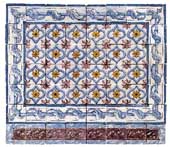|
|
|
|
|
|
|
|
|
|
|
|
|
 |
|
|
|
|
|
|
|
|
|
 |
|
|
|
|
|
|
|
|
The XVIII Century
The Rococo
|
 In the mid XVIII century the tastes of Portuguese society underwent a change with the adoption of a grammatical form of decoration that was influenced partly by the French Regency style, but above all by Rococo engravings from central Europe. In the mid XVIII century the tastes of Portuguese society underwent a change with the adoption of a grammatical form of decoration that was influenced partly by the French Regency style, but above all by Rococo engravings from central Europe.
The preference for organic forms - the most typical example of which is the irregular shell - can be seen in delicate compositions in which the decorative effects were first achieved by the use of two contrasting tones of blue and then by that of various colours.
Most of the figurative panels of the period display gallant and bucolic scenes taken from engravings by Watteau.
The earthquake which destroyed Lisbon in 1755 meant that the city had to be rebuilt from scratch. Ancient tile patterns were retrieved as a means of enlivening an architectural style that had become very bare and functional due to the urgency of the reconstruction work. This type of tiling became known as "Pombaline", after the Marquis of Pombal, who, as King Dom José I's chief minister, was responsible for rebuilding Lisbon.
Along with the religious themes in the churches, it became very popular to place small devotional panels on the façades of buildings as a protection against great disasters.
|
|
|
|
|
The Marquis of Pombal?s Palace, The Fishing Building,
Oeiras, 3rd quarter of the XVIII century.
photograph: Nicolas Lemonnier
|
|
|
 |
|
 |
|
|
Palace of the Counts of Mesquitela,
Lisbon, 3rd quarter of the XVIII century.
photograph: Nicolas Lemonnier
|
|
|
|
|
|
|
|
 |
 |
|
|
|
|
|
|
|
|
Quinta dos Azulejos,
Lisbon, 3rd quarter of the XVIII century.
photograph: Nicolas Lemonnier
|
|
|
|
|
|
Lisbon, 3rd quarter of the XVIII century.
photograph: Nicolas Lemonnier
|
|
|
|
|
|
|
"Pombaline" pattern tiles,
1760 · 1780, MNA cat. 914.
photograph: José Pessoa (DF-IPM)
|
|
|
|
|
|
|
|
|
|
© Instituto Camões, 2000
|
|
|
|